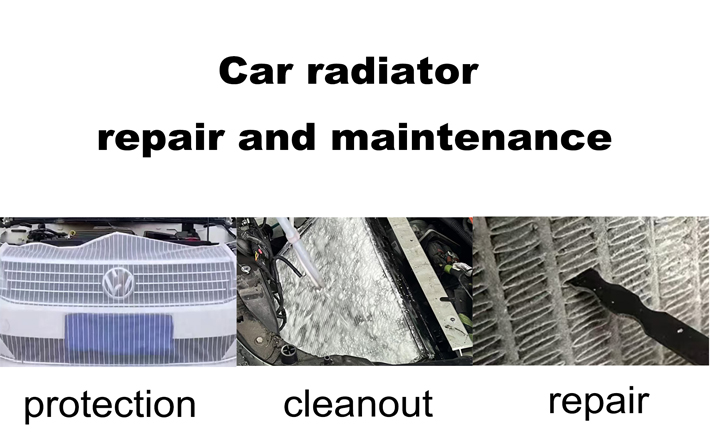Car radiator repair and maintenance guide.
2025-03-28
The car radiator is the core component of the cooling system, responsible for cooling the engine and preventing overheating damage. Proper repair and maintenance can extend its life and ensure efficient operation of the engine. Here are the steps:

Daily maintenance
1. Check the coolant regularly
Liquid level check: Check the liquid level of the expansion tank or radiator when the car is cold, and it should be between "MIN" and "MAX", and add the same type of antifreeze when it is insufficient.
Quality check: If the coolant discoloration (rust yellow, turbidity), impurities or precipitation, need to be completely replaced (generally 2 years or 40,000 kilometers replacement).
2. Clean the surface of the heat sink
External cleaning: Use a soft brush or low pressure air gun to remove dust, catkins, insects, etc., from the radiator fins (avoid high pressure water guns to prevent fin deformation).
Maintain ventilation: Avoid installing shielding (such as insect-proof mesh is too dense), which will affect the heat dissipation efficiency.
3. Check water pipes and tightness
Check whether the rubber water pipe is aging, cracking or leaking, and whether the clamp is loose.
Observe whether there is leakage after the cold car starts (focus on checking the pump and the interface).
4. Check the radiator cover
The failure of the radiator cap pressure valve will result in abnormal cooling system pressure (normal pressure is usually 90-120kPa), which needs to be tested or replaced regularly (it is recommended to check every 50,000 km).
5. Check the heat dissipation fan
When starting the air conditioner, the fan should run automatically; If not, check fuses, relays, or temperature switches.
Clean the fan blades and check whether the motor has abnormal sound or stuck.
Common maintenance methods
1. Repair the radiator leakage
Small leakage: You can use radiator plugging agent (temporary solution), or find a professional technician to repair welding (aluminum radiator requires argon arc welding).
Serious damage: If the radiator is corroded, deformed, or damaged by impact, replace it with a new one.
2. The heat sink is blocked
Remove radiator and reverse rinse with special cleaning agent.
In case of serious blockage, ultrasonic cleaning or replacement of a new radiator can be used.
3. Replace the coolant
Drain the old liquid: Open the radiator drain valve (or remove the water pipe) to drain the old coolant.
Cleaning system: Rinse with distilled water or special cleaning agent to remove scale and rust.
Add new liquid: mix antifreeze and distilled water according to the proportion required by the manufacturer, and exhaust the air after filling (some models need to manually exhaust).
4. The heat dissipation fan is faulty
No rotation: Check fuses, relays, temperature switches and motors.
Abnormal noise: Clean or replace the fan bearing/motor.
Matters needing attention
No hot car open the lid! Cooling system high temperature and high pressure, rash open easy to burn.
Antifreeze can not be mixed, different brands/colors may occur chemical reactions, resulting in corrosion or blockage.
Distilled water can be added in an emergency, but the antifreeze should be replaced as soon as possible afterwards (tap water is easy to scale).
Must check before long distance: Avoid cooling system failure resulting in high temperature engine cylinder pulling.
Recommended maintenance period
Check coolant level: monthly/before long distance
Clean the radiator surface: every 6 months or when the seasons change
Coolant replacement: every 2 years or 40,000km
Check radiator caps & water pipes: every 50,000 km
Complete inspection of the cooling system: every 30,000 km or when the engine is hot
Summary
The key to radiator maintenance is to check the coolant regularly, keep it clean, and repair leaks in time. If it is found that the engine high temperature and coolant are abnormally reduced, it is necessary to overhaul immediately to avoid more serious engine damage. Complex problems are recommended to be handled by professional technicians.